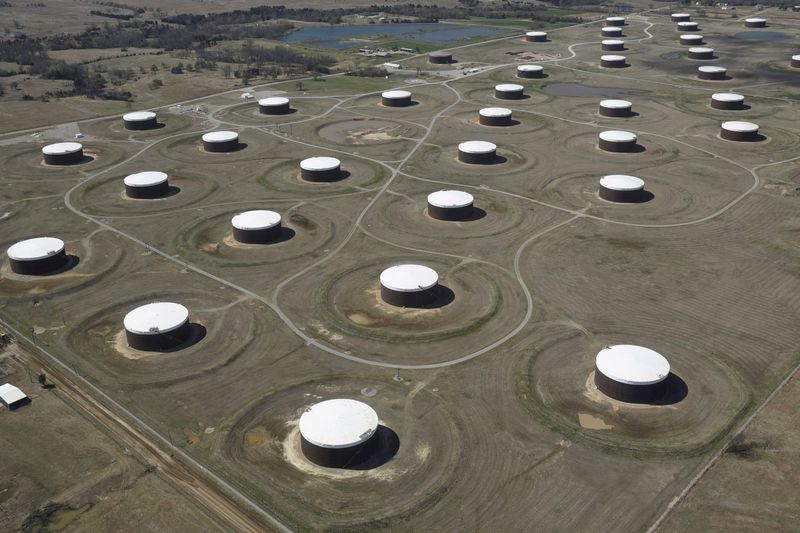SHANGHAI/SINGAPORE/NEW YORK (Reuters) – The crash in U.S. crude prices has turned a reliable commodity less than worthless and given fresh urgency to bearish voices, who say it sounds alarm bells for global growth and are bracing for a catastrophic collapse in asset prices.
Markets are already unnerved at the specter of traders paying to get rid of May futures contracts for West Texas Intermediate crude <CLc1>, as storage tanks at the delivery point in Oklahoma quickly fill with unused fuel.
But some market participants believe the transformation of “black gold” into a liability is more than a bet gone wrong, and rather heralds a new round of deflation and financial destruction as the COVID-19 pandemic wrecks the world economy.
“This is part of the deflation process,” said Murray Gunn, head of global research at market forecasting firm Elliott Wave International.
“At this juncture, our analysis suggests that this is very probably the second wave of a much bigger fall… over the next two or three years we will be in a deflationary environment. Survival will be paramount. And cash is king.”
The crash has already knocked the wind from a rebound rally that has taken the MSCI World Index <.MIWD00000PUS> up more than 20% from March lows, sending Asian shares on their steepest tumble in a month and U.S. stocks sliding two days in a row.
Those preparing for worse to come see a slew of more fundamental problems ranging from oil speculators going bust to the destruction of the U.S. shale industry and a credit crunch if energy firms’ bad debts grow and banks tighten their belts.
“What we’re seeing here is this fast-forward recession,” said Patrick Perret-Green, head of research at AdMacro, a boutique research and investment advisory in London.
Trading losses can quickly spread risks outward to banks, who are likely to respond by lending less, he said.
“Then the question is do they then start re-evaluating other things? So, all commodities trading, copper, the whole shebang … we’re reading the fundamental collapse as something not just for oil but for everything.”
OIL UNDER WATER
The price crash also reflects the near total absence of energy demand – once regarded as constant.
While that has some hoping cheap fuel could subsidize a swift return to global growth, it also means relief could be distant indeed for exporters and economies reliant on them.
“Ultimately, this virus has to get fixed before oil can make any kind of recovery,” said David Winans, principal, U.S. investment grade credit research at PGIM Fixed Income.
“This price doesn’t work for anyone, but it’s unclear to me what more can be done without getting a ‘fix’ on the virus. I suppose oil has tested positive for COVID-19.”
Global stimulus sparked by the pandemic has ballooned to some $8 trillion according to figures from the International Monetary Fund. The U.S. Federal Reserve alone has pledged trillions, widening for some the gap between financial markets and the real economy.
While crude futures prices collapsed and millions of Americans have lost their jobs so far this month, the S&P 500 stock index has rallied over 20% from last month’s lows despite estimates for a recession sharper than the Great Depression.
“Every economic data estimate as we got closer (to its release) got more apocalyptic and in every case so far they weren’t bearish enough,” said Grant Williams, author of Things That Make You Go Hmmm… and portfolio and strategy advisor to Vulpes Investment Management in Singapore.
“Yet markets are still willing to take a forecast for S&P earnings and a ‘V-shaped recovery’ from the same people.”
To be sure, not everyone is forecasting gloom, with OCBC economist Howie Lee calling the oil crash “not the end of the world” and not reflective of the entire market, since even crude’s global benchmark Brent <LCOc1> has not dived so far.
And the U.S. Federal Reserve has thrown so much cash at credit markets that contagion seems unlikely.
But the effects on the industry globally, and especially U.S. shale producers who depend on U.S. crude futures in the low $40s per barrel to break even, are deleterious and could weigh on growth if their usually huge capex spending vanishes.
“At these prices, the entire industry is underwater,” said PGIM’s Winans.
“The ‘supply shock’ from the OPEC+ collapse in March was really a mirage, the demand shock from COVID-19 is overwhelming everything.”
Graphic: U.S. oil plunges, amplifies economic concerns https://fingfx.thomsonreuters.com/gfx/mkt/oakpeknyprd/Pasted%20image%201587473526227.png
(Reporting by Samuel Shen in Shanghai, Tom Westbrook and Vidya Ranganathan in Singapore, Rodrigo Campos in New York and Saikat Chaterjee in London; Editing by Marguerita Choy and Nick Zieminski)



















